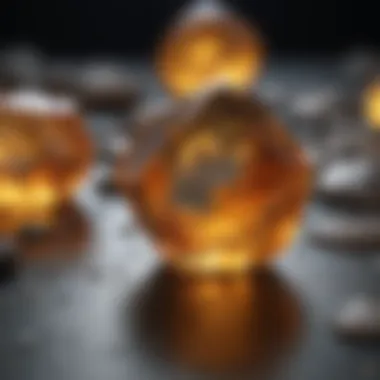Heat Treated Citrine: Properties and Applications


Intro
Citrine, a variety of quartz, has captivated gem enthusiasts and collectors for centuries. Its natural hue can range from pale yellow to a deeper amber, often associated with warmth and positivity. However, heat-treated citrine carries its own unique story and charm. The transformation through heat treatment not only enhances the stone's color but also alters its physical characteristics.
In examining heat-treated citrine, understanding the complex processes behind its enhancement is crucial. Stones are often subjected to high temperatures and sometimes subjected to other treatments to unlock vivid colors and improve clarity. This article explores such methods, illuminating the ethical implications and diverse applications across industries.
Recent Advances
Latest Discoveries
Recent research on heat-treated citrine has unveiled much about its geological origins and the effectiveness of various heating methods. While natural citrine occurs in smaller quantities than amethyst, the latter is frequently altered to produce desirable hues. The discovery that different heating techniques can yield distinct shades of citrine has great implications, particularly in the gem trade. This understanding not only aids gemologists in determining authenticity but also influences market dynamics significantly.
Technological Innovations
Advances in technology have also allowed for more precise control over the heat treatment process. Gemstone producers now employ sophisticated ovens and temperature controls to achieve consistent results. This precision is vital as it minimizes the risk of damaging the stone during treatment. Methods such as infrared spectrometry have become common for assessing the quality of heat-treated citrine, contributing further to the gem's appeal.
"The continuous evolution in gemstone treatments highlights the blend of art and science in the gem industry."
Ethical Considerations
As with any treated gemstone, the ethical landscape is complex. Consumers are increasingly aware of and concerned about how stones are processed. Disclosure of heat treatment is becoming a standard practice among reputable dealers. However, not all sellers fully disclose the treatment status. Educating consumers on how to differentiate between treated and untreated stones is vital.
Applications in Various Industries
Heat-treated citrine finds applications beyond jewelry. It is used in holistic practices and in the design of decorative items. In the wellness industry, heat-treated citrine is often believed to carry metaphysical properties, such as promoting abundance and dispelling negative energy. This belief has led to its incorporation in various types of meditation and spiritual practices.
In the artistic domain, furniture makers and interior designers often utilize citrine in home decor and design elements, bringing a touch of sophistication to their projects.
Ultimately, heat-treated citrine serves as a testament to the interplay between nature and human ingenuity. Its evolving significance in various fields mirrors advancements in gemology and consumer awareness.
Intro to Citrine
Citrine is more than just a gemstone; it carries an intricate history and significance that resonates with various cultures and industries. Understanding citrine serves as a foundation for appreciating its values and uses. The gemstone is cherished not only for its bright, warm color but also for its metaphysical properties, making it an important focus in various fields.
In the context of this article, exploring citrine offers insights into its geological origins and the distinct processes that enhance its appeal, particularly heat treatment. This treatment optimizes the stone's aesthetics and marketability, influencing both consumer preferences and industry demands. Key elements include its rich yellow to golden hues, which delight gem enthusiasts and jewelers alike. Analyzing the definition and origin provides a necessary backdrop to understand the subsequent treatment processes. Moreover, considering the historical significance adds depth to its cultural relevance and allure.
Definition and Origin
Citrine is a variety of quartz, distinguished by its yellow to brownish color. The term "citrine" comes from the French word "citrin," meaning lemon, reflecting the stone's vibrant, citrus-like hues. It is primarily found in igneous and metamorphic rocks and is often formed in the presence of iron. The process that gives rise to its specific color involves heating and geological conditions that influence its formation over millions of years.
Natural citrine is relatively rare, leading to a prevalence of heat-treated amethyst being sold as citrine. This is significant because it highlights the complex strategies employed in the gemstone trade. Understanding the origins is crucial since it shapes the value and authenticity of the stones available in today’s market. The unique process of heat treatment further alters its properties, making it essential knowledge for anyone engaged in gemology.
Historical Significance
The significance of citrine can be traced back to antiquity. Ancient Egyptians valued it for its sunlight-like glow and believed it held protective properties. Additionally, it has been associated with wealth and prosperity across different cultures. In medieval Europe, citrine was often worn as a talisman against various ailments and misfortunes, highlighting its multifaceted role throughout history.
In modern times, citrine symbolizes success and abundance, making it a desired gemstone in jewelry. Besides its aesthetic appeal, citrine's historical roots inform its cultural meanings and significance, thus providing a richer understanding of its value today.
This intersection of history and geology is what makes citrine a fascinating topic for study. Through this exploration, one begins to grasp not just the beauty of the gemstone but also its journey through time and its transformation due to human intervention.
The Process of Heat Treatment
The process of heat treatment is crucial in enhancing the properties of citrine, making it a significant element of this exploration. Heat treatment modifies the stone’s visual appeal and can also affect its physical characteristics. Understanding this process offers insights into why heat-treated citrine occupies a unique position within the gemstone market.
Overview of Heat Treatment Techniques
Heat treatment involves applying controlled heat to citrine at high temperatures. This method often transforms the color and clarity of the gem. Gem enthusiasts and professionals commonly use several techniques:


- Simple Heating: This is the most straightforward method where citrine is heated to a specific temperature that enhances its hue without altering other characteristics significantly.
- Gradient Heating: This technique uses varying temperatures throughout the heating process to achieve more complex color patterns.
- Combined Treatments: Sometimes, citrine undergoes both heat treatment and irradiation to boost color renovation.
These methods are essential for increasing the aesthetic value of the gemstone. The choice of technique can depend on the desired outcome and the specific properties of the raw stone.
Temperature Control and Duration
Temperature control and duration during heat treatment are vital to achieving the desired results.
- Temperature: The heating process usually ranges between 400 to 900 degrees Celsius. Each range negatively or positively affects the mineral composition, leading to differing color outcomes.
- Duration: Holding time varies. Shorter durations may lead to lighter shades, while prolonged exposure often results in deep, saturated colors.
Precision in both temperature and time is critical. Even slight deviations can lead to undesirable colors or destroy the stone's other properties.
Comparison with Other Treatment Methods
Compared to other treatment methods, heat treatment for citrine is relatively straightforward and effective. For example, while dyeing can produce vibrant colors, it often lacks the natural appearance that heating provides. Another method, such as fracture filling, serves to enhance clarity but may compromise the integrity of the gem over time.
In summary, heat treatment stands out for its relatively minimal impact on the stone's natural structural integrity. This process has been pursued for years as a means to produce high-quality citrine for the jewelry market, increasing its desirability and perceived value.
Heat treatment of citrine not only enhances its visual appeal but also adds to its market value, making it a preferred choice among jewelers.
By grasping the fundamentals of heat treatment, stakeholders in the gemstone industry can make informed choices, whether in gem acquisition or customer education.
Chemical and Physical Changes
Understanding the chemical and physical changes in heat-treated citrine is crucial for anyone involved in the gemstone industry. This section provides an insightful analysis of the multiple transformations that occur during the heat treatment process. Both the chemical composition and the structural integrity of the gemstone are affected, which in turn influences its overall appearance and market value.
Color Enhancement Mechanisms
The primary chemical change in heat-treated citrine involves color enhancement. Initially, natural citrine can present in lighter hues of yellow or even pale brown. Through the heat treatment process, the color intensifies. The heat alters the iron oxidation state in the crystal lattice, often transitioning it from a weaker yellow to a more vibrant orange or golden shade. This transformation is important for gem quality, as deeper colors often command higher prices in the market.
Heat treatment typically involves subjecting citrine to temperatures around 500 to 600 degrees Celsius. It is also essential to control the atmosphere during the process. In an oxygen-rich environment, the stone can shift more towards a brown tone, while a reducing atmosphere can yield a more vivid yellow or orange hue. These subtle manipulations can dramatically influence the gemstone's aesthetic appeal and market desirability.
Additionally, the process can cause some color zoning, which may sometimes appear during the formation. These changes are not just surface level; they penetrate deeper into the stone, altering its coloration uniformly or causing variations that can be significant for craftspeople aiming for unique visual effects in jewelry designs.
Alterations in Crystal Structure
Heat treatment does not only affect the visible color; it also induces alterations in the crystal structure of citrine. The primary changes occur in the arrangement of atoms within the crystal lattice, which can affect its physical properties such as hardness and durability. Typically, citrine has a hexagonal crystal system, and this remains intact even post-treatment, but its internal structure may experience shifts in symmetry and bonding angles.
While these changes may seem minor, they can have profound implications. One notable effect is an increase in the gemstone's hardness, which enhances its durability. This is important for jewelers and consumers who seek stones that can withstand wear over time. However, there may also be risks associated with significant temperature fluctuations during treatment, which could lead to fractures or brittleness if not executed properly.
In summary, the chemical and physical changes resulting from heat treatment make heat-treated citrine not only more visually appealing but also enhance its market value. Both color enhancement mechanisms and alterations in crystal structure play crucial roles in determining the suitability of citrine for various applications, ensuring that this gemstone remains a sought-after choice in jewelry and other industries.
"Heat treatment effectively transforms citrine, increasing its desirability and value in the gemstone market."
Properties of Heat Treated Citrine
The properties of heat treated citrine hold significant importance in understanding its overall value and applications. Knowing how heat treatment affects the gemstone can inform both buyers and sellers. It can enhance aesthetic features and improve physical properties, making it a versatile option for various uses. The properties of heat treated citrine are essential when considering its market dynamics and ethical implications.
Aesthetic Features
Color Variations
Color variations in heat treated citrine are one of its most attractive features. Natural citrine typically has a pale yellow hue, but heat treatment can produce a range of rich oranges to deep golden shades. These vibrant colors appeal to consumers, as they can harmonize with different styles and preferences.
The key characteristic of these color variations is their ability to mimic other valuable gemstones, such as imperial topaz. This mimicry allows heat treated citrine to be a popular choice among jewelers and designers. Its affordability compared to other colored gems makes it an accessible option for a wider audience. However, it is important to note that some purists may prefer natural stones, viewing heat-treated gems as less authentic.
The unique feature of these color variations lies in their potential to fade over time if exposed to extreme light conditions. Thus, careful maintenance is advised. Ultimately, the range of colors enhances the desirability of heat treated citrine in the gemstone market.


Clarity and Cut
The clarity and cut of heat treated citrine are critical to its overall appearance. Clarity refers to the presence or absence of inclusions within the stone. Generally, citrine that undergoes heat treatment tends to have fewer inclusions, leading to higher clarity. This quality elevates its visual appeal and commands better pricing.
When discussing cut, a well-executed cut can maximize the gemstone’s brilliance and symmetry. It enhances how light interacts with the stone, showcasing its vibrant hues. The key characteristic of an excellent cut contributes to the stone’s overall market value and aesthetic impact.
The charm of heat treated citrine lies in its ability to maintain clarity while enhancing color. However, one disadvantage is that a poorly cut stone can detract from its quality, leading to a dull appearance. Hence, it is vital to select stones that are not only appealing but also well cut for optimal visual effects.
Physical Properties
Hardness
Hardness is another important property of heat treated citrine, measured on the Mohs scale. This gemstone typically scores around 7, which indicates a good level of hardness. Consequently, it is reasonably resistant to scratches and damage, making it a practical choice for jewelry that may face everyday wear.
The significance of hardness in heat treated citrine lies in its durability. A stone that maintains its beauty over time appeals more to consumers, enhancing its market demand. However, while it is tough, it is not entirely impervious to breaking, especially under heavy impact.
One unique feature of citrine's hardness is that it offers a balance of beauty and practicality. Its durable nature ensures that it retains its visual appeal for many years if properly cared for. Thus, the hardness makes it a highly sought-after option for jewelry designers and retail consumers alike.
Durability
Durability indicates how well a gemstone can withstand various forms of wear and tear. Heat treated citrine exhibits good durability due to its hardness and resistance to common forms of damage. This quality is paramount in applications where stones are subjected to stress, such as in rings and bracelets.
The key characteristic of durability in heat treated citrine allows for frequent use in jewelry. Additionally, it can be cleaned easily without fear of damaging the stone. This trait makes it a preferred choice for individuals seeking a gemstone that they can wear regularly without frequent concerns about maintenance.
One unique feature of its durability is the potential for everyday exposure. Unlike softer stones, heat treated citrine can retain its luster and quality under normal conditions. Thus, this property of durability enhances its overall appeal and solidifies its market standing in the gemstone industry.
Heat treated citrine combines aesthetic beauty with physical resilience, making it a valuable addition to any gemstone collection.
Applications of Heat Treated Citrine
The applications of heat-treated citrine extend beyond mere aesthetics. This gemstone finds relevance in various domains, making it an intriguing subject of discussion. From jewelry to metaphysical uses and even industrial applications, each area reveals diverse benefits and considerations.
Jewelry and Ornamentation
Heat-treated citrine is prominently featured in the jewelry market. Its vibrant hues appeal to designers and consumers alike. The treatment enhances its natural yellow and orange shades, making it a sought-after choice for rings, necklaces, and bracelets. Furthermore, its affordability compared to other gemstones like topaz or even diamonds allows a broader audience to experience its charm.
When selecting heat-treated citrine for jewelry, clarity and cut are key features. Each piece is crafted to showcase the gemstone’s brilliance, drawing attention when worn. Also, it complements various styles, from contemporary designs to classic motifs. People often choose heat-treated citrine for birthstone jewelry or as a thoughtful gift, highlighting its significance in personal adornment.
Metaphysical Beliefs and Use
In addition to its physical attributes, heat-treated citrine holds a place in the metaphysical community. Many believe it possesses strong energy and healing properties. Often referred to as the "merchant's stone," it is thought to promote abundance and prosperity. Practitioners of crystal healing incorporate citrine in their practices, often placing it in workspaces to attract financial success.
Furthermore, those interested in mindfulness use heat-treated citrine to enhance creativity and motivation. This belief stems from its warm color, which is associated with positivity and clarity of thought. While scientific evidence to support these claims is scant, the cultural significance of citrine in spiritual practices is undeniable.
Industrial Applications
Heat-treated citrine does not only shine in personal adornments and spiritual practices but also finds applications in various industrial sectors. Due to its hardness and durability, it can be used as an abrasive material. Companies engage it in cutting, grinding, and drilling processes. This versatility allows heat-treated citrine to be utilized in manufacturing industries and production lines.
Moreover, the gemstone's optical properties are examined for possible use in specialized lenses and optical devices. Its ability to refract light efficiently can be beneficial in creating components for specific scientific and industrial uses.
Market Dynamics of Heat Treated Citrine
Understanding the market dynamics of heat-treated citrine is crucial for grasping its significance in the gemstone industry. Several factors influence its supply and demand, along with pricing trends that reflect consumer preferences and market health. By examining these elements, we can appreciate the complexities involved in the trade of heat-treated citrine, its aesthetic appeal, and the implications for buyers and sellers.
Supply and Demand Analysis
The supply of heat-treated citrine is largely determined by the availability of citrine itself. Natural citrine is less common than other quartzes, leading to a more significant reliance on heat treatment to enhance its color. The treatment process enables citrine to achieve vibrant yellow and orange hues, increasing its appeal in the jewelry market.


Conversely, demand is influenced by trends in jewelry design and consumer interest in gemstones. For instance, when consumers shift their preferences towards natural and ethically sourced materials, demand for heat-treated stones may fluctuate. Factors such as seasonal promotions, the holiday buying season, and increased awareness of gemstone properties can also play a role in shaping market dynamics.
- Seasonal Demand Factors: Holiday seasons and special occasions often see a spike in jewelry purchases, potentially increasing demand for heat-treated citrine.
- Ethical Sourcing Concerns: The impact of consumer preferences for ethically sourced stones can directly affect the market supply.
- Market Access: New avenues for sales, such as online platforms, offer broader access to consumers and may change supply dynamics.
"The unique qualities of heat-treated citrine create a balance between supply and demand, influencing its overall market stability."
Pricing Trends
Pricing for heat-treated citrine varies based on several factors, including size, clarity, color intensity, and market conditions. The ongoing evolution of these pricing trends reflects changing consumer tastes and the gemstone's perceived value. As heat-treated citrine garners recognition for its aesthetic qualities and affordability, its price can be competitive compared to untreated variants of gemstones.
Key components affecting pricing include:
- Color Quality: Gemstones displaying richer, more vibrant colors generally command higher prices.
- Clarity and Cut: Higher clarity and better cuts increase a stone's value. Skilled craftsmanship also affects the overall market price.
- Market Trends: An increase in popularity can lead to elevated prices as demand rises.
Investors and buyers often study these pricing trends carefully before purchasing, ensuring they understand the fine details that influence the market for heat-treated citrine.
Ethical Considerations
In recent years, the discussion around ethical considerations in gemstone sourcing has gained significant attention. Heat treated citrine, like many other gemstones, is subjected to scrutiny regarding its origins and the methods used in its trade. As consumers become more conscious of the sources of their products, the importance of transparent practices in the industry cannot be overstated.
Sourcing and Trade Ethics
Sourcing of heat treated citrine involves several factors that are crucial for ensuring ethical practices. The primary ethical concerns include the mining processes, the treatment methods employed, and the impact on the communities involved.
Many gemstones are sourced from regions where regulations may not be strictly enforced. This can lead to dire consequences for workers, such as unsafe working conditions, exploitation, and environmental degradation. Therefore, it is essential for vendors to acquire heat treated citrine from reputable suppliers who adhere to ethical mining standards.
Moreover, regulations like the Kimberley Process, which focuses on the trade of diamonds to prevent conflict financing, reflect the growing need for responsible sourcing in gemstones. Consumers should expect similar initiatives for all gemstones, including citrine, to ensure that their purchases do not contribute to unethical practices.
Example practices include:
- Conducting independent audits of suppliers.
- Supporting local communities through fair trade initiatives.
- Choosing suppliers who comply with environmental guidelines.
In this context, certification from recognized organizations can provide assurance about the ethical sourcing of heat treated citrine. Companies that prioritize ethical sourcing not only help to build a better industry standard but also enhance their own brand reputation.
Consumer Awareness
Consumer awareness plays a pivotal role in fostering ethical practices within the gemstone market. Educated consumers can drive demand for ethically sourced heat treated citrine, encouraging suppliers to adopt better practices. Understanding the implications of the purchasing decisions can lead to a shift in how gemstones are valued by society.
To promote ethical practices, consumers should consider the following actions:
- Research the Source: Inquire about where and how the citrine is sourced and treated.
- Seek Certifications: Look for stones that have been certified by reputable organizations that verify ethical sourcing.
- Advocate for Transparency: Support brands that openly share their supply chains and sourcing practices.
By using their purchasing power wisely, consumers can influence the gemstone industry toward more sustainable and responsible practices. Increased demand for ethically sourced heat treated citrine can motivate more suppliers to adhere to ethical standards and contribute positively to the mining communities.
"Consumer choice can drive significant change in the industry. Every purchase has the power to influence better practices."
The End: The Future of Heat Treated Citrine
The future of heat-treated citrine holds great significance for both consumers and professionals in the gemstone industry. As technological advances continue, they influence the treatment methods applied to this attractive stone, impacting its characteristics and marketability. Ensuring that heat-treated citrine maintains its appeal in both aesthetic and functional capacities is essential.
Emerging Trends in Treatment Methods
Currently, innovative approaches in heat treatment have emerged. These methods aim to enhance the color while maintaining the stone's integrity. Techniques such as controlled atmosphere treatment and alternative heating methods could lead to new standards in the gemology field. Not only are gemologists seeking to perfect these processes, but they also work towards minimizing adverse effects on the gems. The increasing awareness among consumers regarding treatment processes further pushes the industry towards transparency.
Moreover, the demand for unique and ethically sourced gemstones is steadily rising. This trend indicates that heat-treated citrine must adapt. Enhanced treatment methods that are environmentally responsible will likely attract a growing clientele. Emphasis on careful documentation of treatment histories will also play a role in building consumer trust.
Sustainability and the Gemstone Industry
Sustainability is a crucial consideration for the future of heat-treated citrine. As society becomes more conscious of environmental impacts, the gemstone industry faces pressure to adopt sustainable practices. Mining, treatment, and distribution processes need examination to reduce their carbon footprint. Companies committed to sustainable practices could experience increased loyalty from customers who prioritize green practices.
Additionally, finding alternative sources for citrine, such as synthetic options, may help reduce overexploitation of natural resources. The heat-treated citrine market can benefit from this shift towards sustainability, ensuring that the beauty of gemstones does not come at the expense of the planet. Collaboration among stakeholders in the industry can foster practices that promote sustainability while maintaining profitability.
"The intersection of technology and ethical sourcing will define the future landscape of gemstones, including heat-treated citrine."















